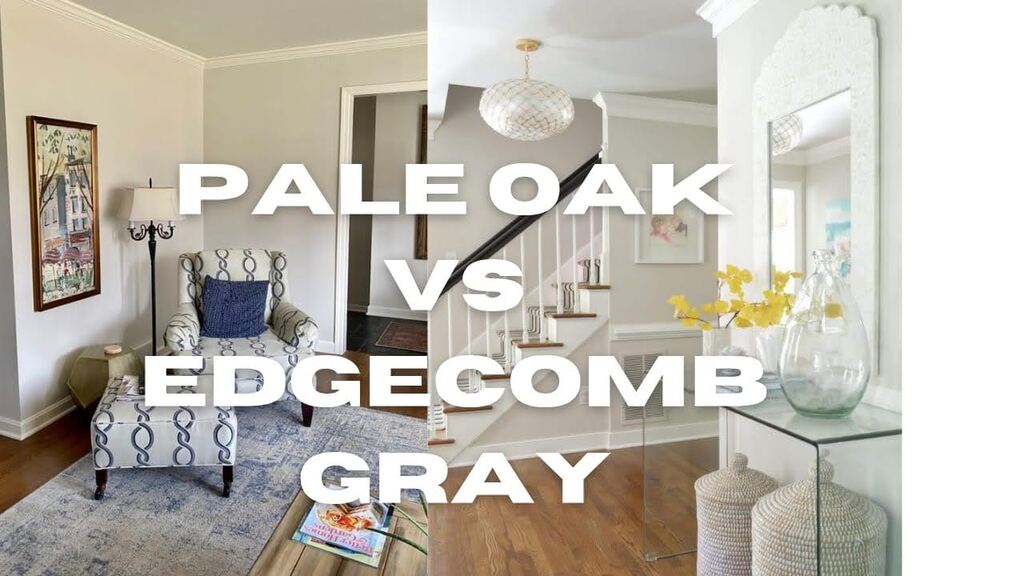In this blog, I’m going to compare the two most popular and similar shades by Benjamin Moore: Pale Oak vs Edgecomb Gray.
Are you torn between Pale Oak and Edgecomb Gray for your next paint project, but can’t decide which one will work best in your space? You’re not alone! Both are warm neutrals that can create a cozy, inviting atmosphere, but they each have unique qualities that might make one a better fit for your home. So, how do you choose between these two beautiful shades?
By the end, you’ll know which color holds the secret to transforming your space into the haven you’ve been dreaming of. Ready to unlock the perfect hue? Let’s explore.
Pale Oak vs Edgecomb Gray
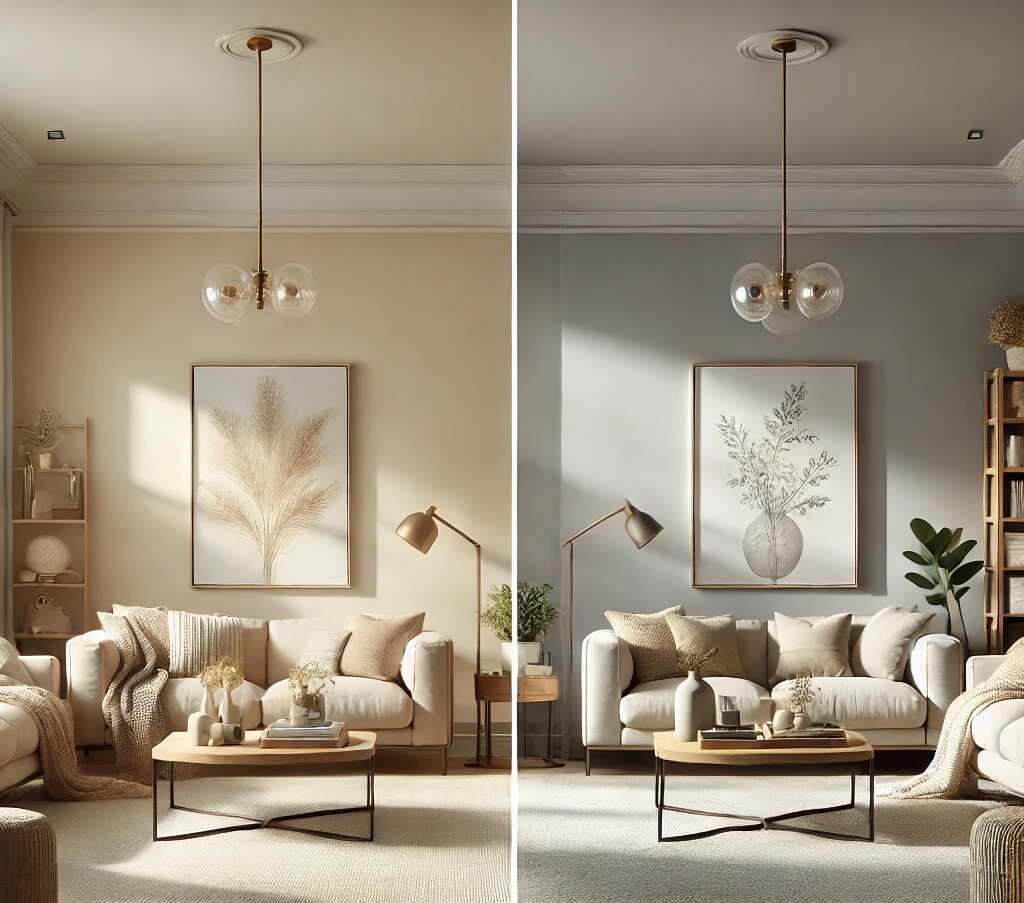
When it comes to choosing between Pale Oak and Edgecomb Gray, understanding their subtle differences can help you make a more informed decision for your home’s aesthetic.
Comparing Undertones
Pale Oak (OC-20) is a soft, warm beige with undertones of pink and light taupe. It has a gentle, inviting warmth that brings a sense of coziness to any space.
The pinkish-beige undertones give it a slightly more traditional or classic feel, making it a great choice for spaces looking to feel calm, elegant, and timeless.
It’s a versatile neutral, but its warmth shines through in spaces with plenty of natural light, where it can appear more beige and soft.
Edgecomb Gray (HC-173), on the other hand, is a light, neutral gray with subtle undertones of beige.
Its overall tone is cooler than Pale Oak, with a greige (gray-beige) base that can lean slightly toward green in certain lighting.
This makes Edgecomb Gray more adaptable and modern, with a cleaner, more understated feel.
While it still offers warmth, its cooler undertones give it a more versatile, slightly more contemporary vibe that can work well in both warm and cool spaces.
Comparing LRVs
Pale Oak (OC-20) has an LRV of 68, which means it reflects a moderate amount of light. This makes it a good choice for rooms that may not receive an abundance of natural light, as it will help keep the space feeling light and airy without being too stark.
Edgecomb Gray (HC-173) has a slightly higher LRV of 63. While this is still considered a light color, it reflects just a bit less light compared to Pale Oak. As a result, it tends to appear a little softer and more muted, particularly in dimmer spaces.
Pale Oak (OC-20), will appear soft and inviting in a north-facing room. The warmth in the color will counterbalance the coolness of the light, helping to create a more comfortable, welcoming environment.
Edgecomb Gray (HC-173), will perform well in south-facing rooms. It won’t appear too warm under the strong sunlight, making it a great choice if you want a more balanced, sophisticated look. The light will bring out its beige notes, making it feel warm yet subdued.
Comparing RGB
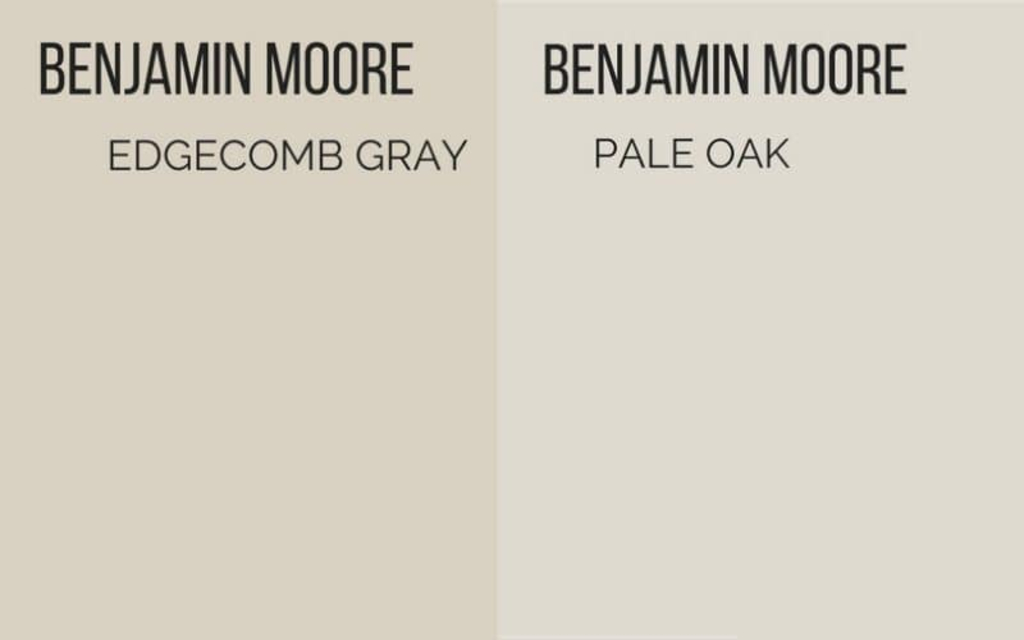
When comparing the RGB (Red, Green, Blue) values of Pale Oak (OC-20) and Edgecomb Gray (HC-173), we can get a deeper understanding of how they differ in terms of their overall appearance and how they interact with lighting.
Pale Oak (OC-20) RGB:
- Red: 204
- Green: 194
- Blue: 177
Pale Oak has a slightly warmer, more beige base, as reflected in its RGB values.
With a higher red value (204) and a fairly balanced green and blue, it leans into those warm, pinkish-beige tones that give it a soft, welcoming feel.
It has a subtle warmth, which makes it a great choice for creating a cozy and inviting atmosphere.
Edgecomb Gray (HC-173) RGB:
- Red: 202
- Green: 200
- Blue: 189
Edgecomb Gray has slightly more balance between the red, green, and blue components, with all three values coming in closer to each other.
This gives it a more neutral quality. The subtle difference in the green and blue values compared to Pale Oak makes it appear a little cooler and less pink, resulting in a more versatile and sophisticated tone.
It’s the kind of color that effortlessly blends into various spaces, offering a soft yet sophisticated neutral backdrop.
Coordinating Colors
When it comes to coordinating colors with Pale Oak and Edgecomb Gray, understanding how they complement other shades in your space can elevate your design to the next level.
Coordinating Colors for Pale Oak (OC-20):
- White Dove (OC-17)
- Accessible Beige (SW 7036)
- Revere Pewter (HC-172)
- Softened Green (SW 6177)
- Wickham Gray (HC-171)
- Sea Salt (SW 6204)
- Pure White (SW 7005)
- Dinner Party (CC-158)
- Timber Wolf – Benjamin Moore 1471
- Chantilly Lace (OC-65)
Coordinating Colors for Edgecomb Gray (HC-173):
- White Smoke (OC-18)
- Alabaster (SW 7008)
- Gray Owl (OC-52)
- Repose Gray (SW 7015)
- Mindful Gray (SW 7016)
- Silver Chain (OC-27)
- Whole Wheat (SW 6121)
- Dove Wing (OC-18)
- Pashmina (AF-100)
- Boothbay Gray (HC-165)
Lighter Versions of Edgecomb Gray and Pale Oak
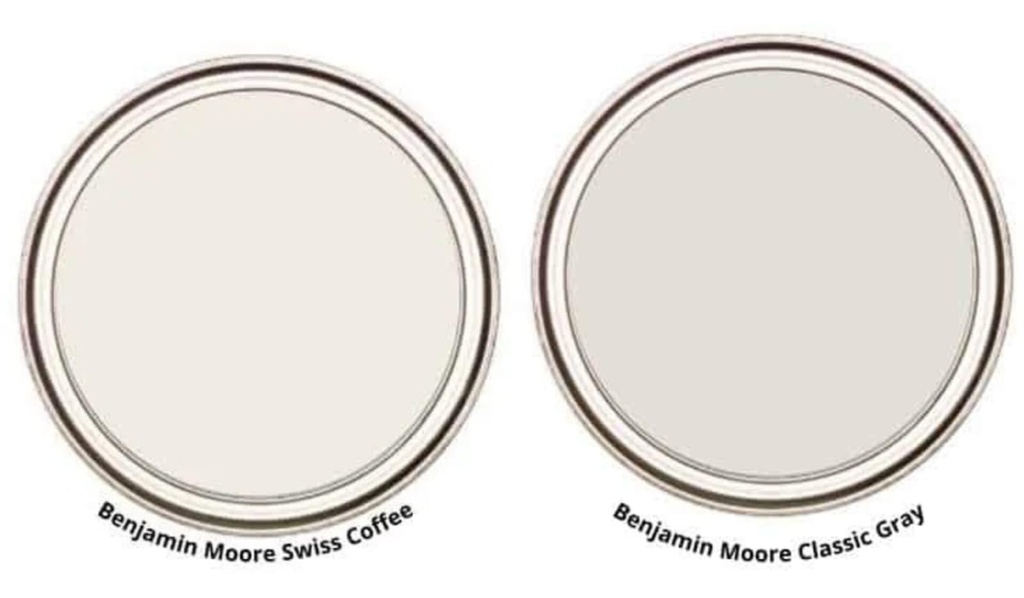
If you’re looking for a lighter take on Pale Oak and Edgecomb Gray, you’re in luck! These softer versions can give you that same warm, neutral vibe but with an airier, more delicate feel.
For Pale Oak, consider Swiss Coffee (OC-45) – it’s a light, warm beige that offers the same cozy appeal without being too dark, making it perfect for smaller rooms or spaces with less natural light.
As for Edgecomb Gray, Classic Gray (OC-23) is a great option. It’s a lighter, cooler version of Edgecomb Gray with just a touch of warmth, creating a more subtle, serene look while still retaining that adaptable greige feel.
These lighter shades will help keep your space feeling open and fresh while still giving you the timeless, neutral elegance of the original colors.
Similar Colors in Different Brands
When exploring Pale Oak and Edgecomb Gray, you may want to check out similar shades from other popular paint brands to find the perfect match for your space. Here are three great options:
Sherwin-Williams:
Pale Oak Similar: Accessible Beige (SW 7036) – A soft, warm beige that echoes the cozy, inviting tone of Pale Oak but with a bit more beige and less pink.
Edgecomb Gray Similar: Repose Gray (SW 7015) – A beautiful greige with subtle undertones of both gray and beige, creating a more neutral, versatile alternative to Edgecomb Gray.
Behr:
Pale Oak Similar: Candlelit Beige (720C-2) – A light, warm beige with subtle pink undertones that resemble Pale Oak’s soft and inviting vibe.
Edgecomb Gray Similar: Silver Drop (790C-2) – A light gray with just a touch of beige, offering a comparable, lighter option to Edgecomb Gray’s soft greige.
Farrow & Ball:
Pale Oak Similar: Skimming Stone (No. 241) – A light, warm gray with beige undertones, offering a similar warmth and softness to Pale Oak.
Edgecomb Gray Similar: Cornforth White (No. 228) – A balanced, soft gray with a slight beige undertone, perfect for mimicking Edgecomb Gray’s understated neutral look.
Where to use Pale Oak and Edgecomb Gray?
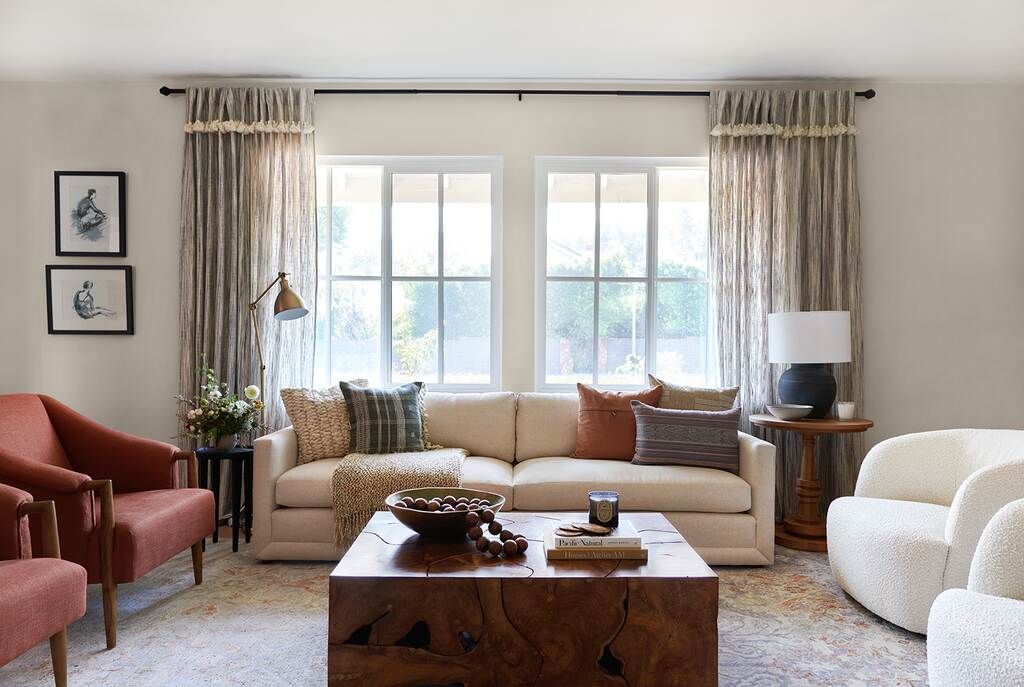
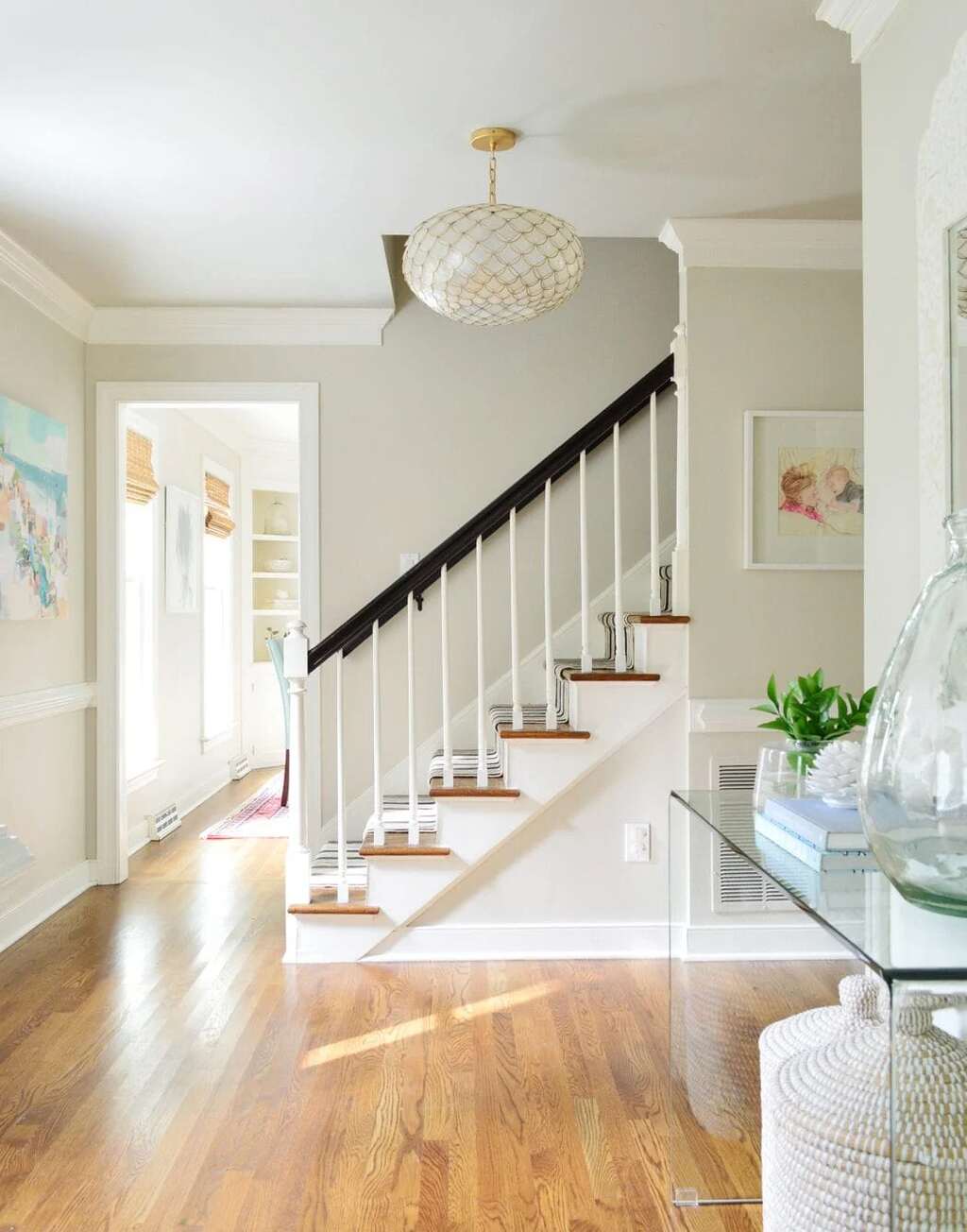
Having tried both Pale Oak and Edgecomb Gray in different spaces, I can tell you firsthand how wonderfully they transform a room.
Pale Oak (OC-20) is perfect for creating a warm, inviting atmosphere, especially in living rooms and bedrooms.
I used it in my living room, and it immediately made the space feel cozier without feeling dark or heavy.
It’s especially great for rooms with a lot of natural light, as it brightens up the space while maintaining that soft, warm vibe.
If you’re looking to create a relaxed, comfortable retreat, I highly recommend giving Pale Oak a try, especially in open living areas or areas that get plenty of natural light.
On the other hand, Edgecomb Gray (HC-173) has this amazing ability to work in almost any space.
I’ve used it in both a hallway and my kitchen, and it gave the areas just the right balance of warmth and neutrality.
Edgecomb Gray feels sophisticated yet calm, making it an excellent choice for dining rooms, kitchens, or even bathrooms where you want a subtle, elegant background.
If you’re looking to achieve a timeless look in any part of your home, I suggest considering Edgecomb Gray—it truly adapts to different lighting and surroundings so effortlessly.
So, whether you’re aiming for a welcoming, cozy living room with Pale Oak or a classic, timeless vibe with Edgecomb Gray, these shades will deliver that effortless beauty in any room you choose.
Here’s a comparison table for Pale Oak and Edgecomb Gray to highlight their key differences and similarities:
|
Feature |
Pale Oak (OC-20) |
Edgecomb Gray (HC-173) |
|
RGB Values |
R: 204, G: 194, B: 177 |
R: 202, G: 200, B: 189 |
|
LRV |
68 |
63 |
|
Undertones |
Warm pink, taupe, beige |
Cool gray with beige and green |
|
Tone |
Soft, warm, cozy |
Neutral, balanced, sophisticated |
|
Best For |
Living rooms, bedrooms, hallways |
Kitchens, dining rooms, bathrooms |
|
Lighting |
Works well with natural light |
Adaptable to bright or dim lighting |
|
Coordinating Colors |
White Dove, Revere Pewter, Softened Green |
White Smoke, Repose Gray, Mindful Gray |
|
Room Feel |
Welcoming, calm |
Serene, clean, modern |
|
Trim Color |
Crisp whites like Chantilly Lace |
Off-white like White Dove |
Conclusion
In conclusion, both Pale Oak and Edgecomb Gray offer timeless, versatile options for creating a neutral yet warm atmosphere in your home. Whether you’re looking to brighten up a living room, add elegance to a dining room, or create a serene retreat in your bedroom, both colors are excellent choices. It all comes down to the vibe you want to create: a cozy, welcoming environment with Pale Oak or a sophisticated, balanced backdrop with Edgecomb Gray.
No matter which you choose, both colors will seamlessly complement your home, giving it that timeless, warm, and inviting feel we all crave. Happy painting.
FAQs
What trim colors look best with Pale Oak or Edgecomb Gray?
For Pale Oak, I recommend pairing it with crisp white trims like Chantilly Lace for a fresh contrast. With Edgecomb Gray, off-white trim colors such as White Dove or Simply White work wonders to complement its soft, grayish warmth.
Can I use Pale Oak or Edgecomb Gray in my kitchen?
Absolutely! Both colors are versatile neutrals that work beautifully in a kitchen. Pale Oak gives a warm, creamy look, perfect for a cozy, inviting atmosphere, while Edgecomb Gray offers a softer, more subtle contrast for a modern yet classic style.
How can I test these colors before committing?
It’s always a good idea to test your paint colors first! Consider ordering samples from a service like Samplize. They deliver peel-and-stick paint samples, so you can easily test the colors in your own home’s lighting before making a final decision.
What other brands offer similar colors to Pale Oak and Edgecomb Gray?
If you’re considering other paint brands, Sherwin Williams’ Agreeable Gray is a close match to Edgecomb Gray, while Behr’s Wind Rush offers a similar tone to Pale Oak. Be sure to test them in your space to find the perfect match.
What lighting works best for Pale Oak and Edgecomb Gray?
Both colors will appear differently depending on the type of lighting. Pale Oak leans more gray or even lavender in rooms with northern light, while Edgecomb Gray maintains its soft grayish hue in most settings. Make sure to test them in different light sources to see their true beauty.

